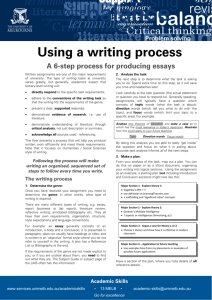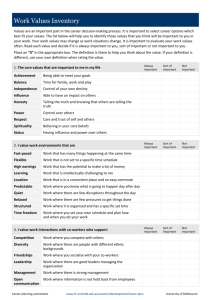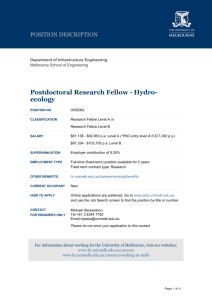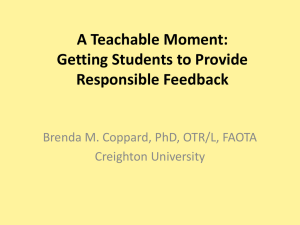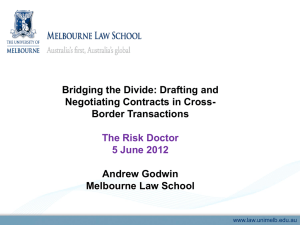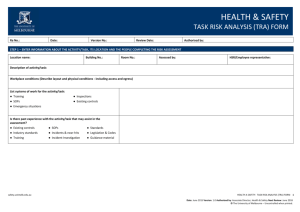Publications - Education Student Home Page : Faculty of Education
advertisement
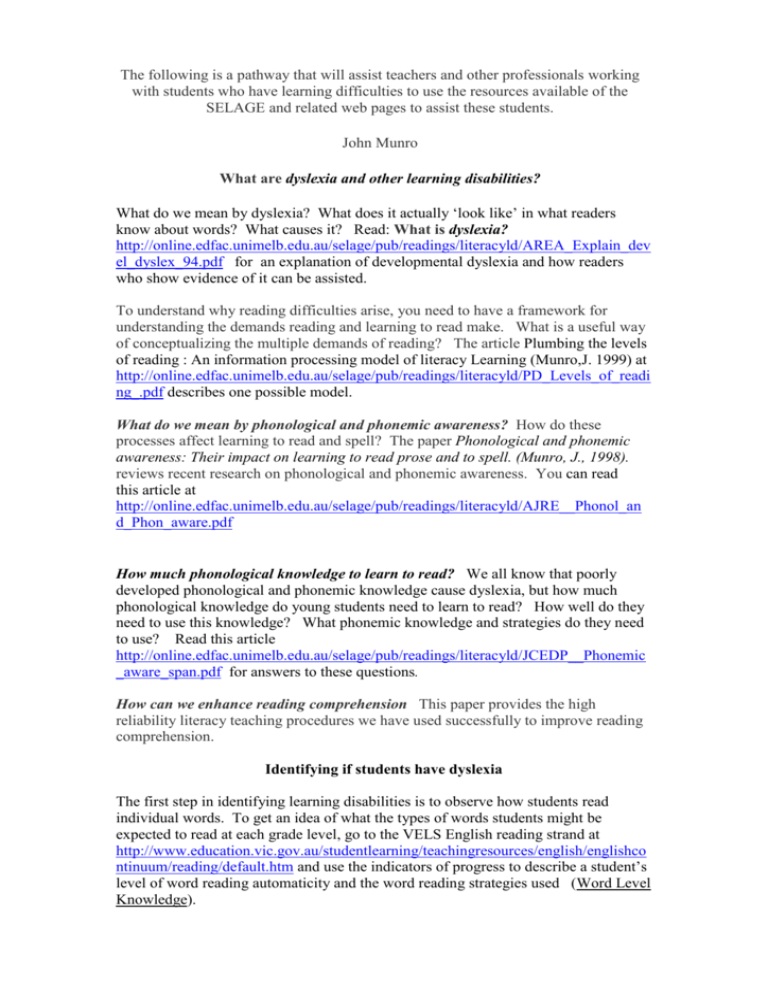
The following is a pathway that will assist teachers and other professionals working with students who have learning difficulties to use the resources available of the SELAGE and related web pages to assist these students. John Munro What are dyslexia and other learning disabilities? What do we mean by dyslexia? What does it actually ‘look like’ in what readers know about words? What causes it? Read: What is dyslexia? http://online.edfac.unimelb.edu.au/selage/pub/readings/literacyld/AREA_Explain_dev el_dyslex_94.pdf for an explanation of developmental dyslexia and how readers who show evidence of it can be assisted. To understand why reading difficulties arise, you need to have a framework for understanding the demands reading and learning to read make. What is a useful way of conceptualizing the multiple demands of reading? The article Plumbing the levels of reading : An information processing model of literacy Learning (Munro,J. 1999) at http://online.edfac.unimelb.edu.au/selage/pub/readings/literacyld/PD_Levels_of_readi ng_.pdf describes one possible model. What do we mean by phonological and phonemic awareness? How do these processes affect learning to read and spell? The paper Phonological and phonemic awareness: Their impact on learning to read prose and to spell. (Munro, J., 1998). reviews recent research on phonological and phonemic awareness. You can read this article at http://online.edfac.unimelb.edu.au/selage/pub/readings/literacyld/AJRE__Phonol_an d_Phon_aware.pdf How much phonological knowledge to learn to read? We all know that poorly developed phonological and phonemic knowledge cause dyslexia, but how much phonological knowledge do young students need to learn to read? How well do they need to use this knowledge? What phonemic knowledge and strategies do they need to use? Read this article http://online.edfac.unimelb.edu.au/selage/pub/readings/literacyld/JCEDP__Phonemic _aware_span.pdf for answers to these questions. How can we enhance reading comprehension This paper provides the high reliability literacy teaching procedures we have used successfully to improve reading comprehension. Identifying if students have dyslexia The first step in identifying learning disabilities is to observe how students read individual words. To get an idea of what the types of words students might be expected to read at each grade level, go to the VELS English reading strand at http://www.education.vic.gov.au/studentlearning/teachingresources/english/englishco ntinuum/reading/default.htm and use the indicators of progress to describe a student’s level of word reading automaticity and the word reading strategies used (Word Level Knowledge). You can use the checklist at http://online.edfac.unimelb.edu.au/LiteracyResearch/pub/teaching_strategies/checklist .htm to screen the student’s reading difficulties and to get a better insight into the types of reading difficulty. You could ask the student to read the set of single syllable words at http://online.edfac.unimelb.edu.au/LiteracyResearch/pub/tests/orth_test.htm and the multisyllabic words at http://online.edfac.unimelb.edu.au/LiteracyResearch/pub/tests/multisyllabic.pdf What is a useful systematic framework for identifying why a reader is having reading difficulties? If you believe the student has relative difficulty reading the relevant types of words, you may want to examine the student’s word reading ability in greater depth. A framework for diagnosing a student’s reading disabilities is at http://online.edfac.unimelb.edu.au/selage/pub/readings/literacyld/RD_spi_ceo__part_ 4_diag.pdf. Pages 20-24 guide you through assessing word knowledge. Does the student have associated phonological knowledge or rapid naming difficulties? To see whether the word reading difficulties are caused by either phonological knowledge or rapid naming difficulties, you can first return to the VELS English reading strand where you will find indicators of progress phonological knowledge up to grade 5 and Letter and Letter Name Knowledge up to grade 2. The indicators at each 6-month age level tell you what is reasonable to expect for a child of that age and you can locate where the particular child is. You can find templates for recording developmentally a student’s phonological knowledge on page 29 of http://online.edfac.unimelb.edu.au/selage/pub/readings/literacyld/RD_spi_ceo__part_ 4_diag.pdf. You can access a rapid naming test at http://online.edfac.unimelb.edu.au/LiteracyResearch/pub/tests/RAN.htm phonological short term memory task at http://online.edfac.unimelb.edu.au/LiteracyResearch/pub/tests/PhonSTM.htm a phonological recoding task using pseudowords at http://online.edfac.unimelb.edu.au/LiteracyResearch/pub/tests/LSD.htm, an orthographic processing task at http://online.edfac.unimelb.edu.au/LiteracyResearch/pub/tests/OPW.htm, a rime reading task at http://online.edfac.unimelb.edu.au/LiteracyResearch/pub/tests/37_RIME_TEST2006. pdf a visual symbolic processing task http://online.edfac.unimelb.edu.au/LiteracyResearch/pub/tests/VSP_SRS.pdf and learning an orthographic code task at http://online.edfac.unimelb.edu.au/LiteracyResearch/pub/tests/LOC.htm You can see assessments of students’ individual word reading at http://online.edfac.unimelb.edu.au/LiteracyIntervention/redliteracy/contents/edaer/vi deoclips/jeremy9a.html, http://online.edfac.unimelb.edu.au/LiteracyIntervention/redliteracy/contents/edaer/vi deoclips/julia9a.html and http://online.edfac.unimelb.edu.au/LiteracyIntervention/redliteracy/contents/edaer/vi deoclips/nick9a.html . You can see assessments of students’ prose reading comprehension at http://online.edfac.unimelb.edu.au/LiteracyIntervention/redliteracy/contents/edaer/vi deoclips/jeremy2a.html ,http://online.edfac.unimelb.edu.au/LiteracyIntervention/redliteracy/contents/edaer/v ideoclips/jeremy3a.html http://online.edfac.unimelb.edu.au/LiteracyIntervention/redliteracy/contents/edaer/vi deoclips/nick2a.html and at http://online.edfac.unimelb.edu.au/LiteracyIntervention/redliteracy/contents/edaer/vi deoclips/nick3a.html Implementing literacy teaching interventions for students who have dyslexia and other reading disabilities You can see over 300 sets of researched and validated teaching procedures at http://online.edfac.unimelb.edu.au/LiteracyResearch/pub/teaching_strategies/ts_ list.htm. These sets of teaching procedures are parts of Dr John Munro’s approach to literacy intervention, the HRLTPs. They have been designed by teachers, principals, school advisers, reading recovery tutors and speech pathologists employed by Catholic Education Office, Melbourne. Each set of teaching procedures is accompanied by a research report that describes its implementation. You will find descriptions of lesson plans for teaching particular literacy teaching procedures to students who have reading difficulties and assessment tasks. Most of the research studies have involved primary school students. The procedures can usually be adapted for use with secondary students. The sequences of teaching procedures have been organized around the model for understanding literacy learning disabilities into the following categories. You can select from the collection the particular sets of teaching procedures that best meet the needs of your students: 1. 2. 3. 4. 5. 6. 7. 8. 9. 10. 11. 12. 13. 14. 15. self efficacy, resilience as a reader and learner phonological and phonemic thinking strategies (onset & rime, segmenting & blending, stress patterns... ) rapid automatised naming (RAN) using analogy to read unfamiliar words using visualizing and verbalizing (and visual organizers) to comprehend sentences using synonyms and paraphrasing to comprehend sentences using predicting for inferential comprehension using questioning for inferential comprehension teaching self management and self-talk vocabulary building/word meanings sentence structure/grammar/syntax/phrasing/intonation/punctuation repeated reading teaching grammar oral language parent training and assessment (speech pathology) program / resource / test reviews. Which intervention works best? Young students display reading disabilities for multiple reasons. They need an intervention that targets the cause of their difficulty. This paper describes a research that evaluate the effectiveness of three intervention options for students in Year 2 who have been identified as at risk of experiencing ongoing reading difficulties. You can read it at http://online.edfac.unimelb.edu.au/selage/pub/readings/literacyld/literacy_interventio n-1.pdf The research was funded by the Literacy and Numeracy Innovative Projects Initiative of the Commonwealth of Australia in 2005. Seeing the teaching procedures demonstrated. You can see the strategies teaching framework and the teaching procedures being demonstrated with students at Bellfield Primary School at http://online.edfac.unimelb.edu.au/LiteracyIntervention/redliteracy/contents/interventi on/whattoteachreading.html You can see them being used with secondary students at http://www.education.vic.gov.au/studentlearning/teachingresources/english/literacy/st rategies/literacytolearn.htm#1 Details of the three phases of teaching are at: Before reading strategies : http://online.edfac.unimelb.edu.au/LiteracyIntervention/redliteracy/contents/interventi on/beforereading.html 1. 2. While reading strategies : http://online.edfac.unimelb.edu.au/LiteracyIntervention/redliteracy/contents/in tervention/whilereading.html After reading strategies http://online.edfac.unimelb.edu.au/LiteracyIntervention/redliteracy/contents/in tervention/afterreading.html. The recommended framework for teaching word reading skills is described at http://online.edfac.unimelb.edu.au/LiteracyIntervention/redliteracy/contents/interventi on/howtoteachliteracy.html You can see materials for teaching strategies in each area at http://www.aiz.vic.edu.au/Documents/ and follow up files labelled Literacy and John Munro. These include 1. Paraphrasing nmr-my-paraphrasing.doc 2. Say questions the text answers Say-questions-the-text-answersp.pdf 3. Summarize the text. Summarize-the-text-sent-pdf.pdf 4. Vocabulary Vocabulary-mine-train-sentp.pdf 5. Reading Aloud Reading-aloudp.pdf 6. Getting Knowledge Ready nmr-GKR-sent3.pdf 7. Implementation Plan implementation-plan-sent.doc 8. HRLTPS.doc 9. Phonological Knowledge and Literacy Learning by Indigenous Students. NIEC-3-John-Munro-1.ppt 10. Vocab nmr-VOCAB-for-website-5-2-sept.ppt 11. A Literacy Implementation Plan PD-a-literacy-implementation-plan.ppt Does your student have oral language difficulties? Aspects of oral language development are often part of the cause of literacy difficulties. If you need assessment and teaching activities in this area, you can access the Language Disorders Program I designed and developed the Language Disorders Program for the DEECD. The link for this resource is http://www.education.vic.gov.au/studentlearning/programs/lsp/default.htm If your students have word reading difficulties, that is, various forms of dyslexia, you can read about a teaching program that integrates phonological, phonemic, semantic, phonic and orthographic teaching in a systematic way at http://online.edfac.unimelb.edu.au/selage/pub/readings/literacyld/AJRE_POLP_.pdf Integrating phonological, semantic, phonic and orthographic teaching describes a teaching program that does this. The effectiveness of the program has been shown repeatedly in school improvement. It was the teaching program that was used at Bellfield Primary School in Victoria in 1997- 2005 and led to the significant literacy improvement there. Implementing school level literacy teaching interventions for students who have dyslexia and other reading disabilities The significant literacy improvement at Bellfield Primary School in Victoria in 19972005 has been recognised repeatedly in recent years. The Bellfield literacy story at http://online.edfac.unimelb.edu.au/selage/pub/readings/literacyld/brydon__BPS__2=0 4.pdf is a case study that describes the professional learning and development activities that were put in place on a whole school basis to achieve the improved student outcomes in literacy at the school. Literacy improvement is possible in a secondary school. It is frequently assumed that is almost impossible The paper Literacy improvement in the Secondary School at http://online.edfac.unimelb.edu.au/selage/pub/readings/literacyld/Art_D_Brydon__04 __sec_sent_.pdf is a case study that disproves this belief. It describes how a systematic professional development program based on an explicit model of literacy, led to improved literacy comprehension outcomes for students. It describes the professional learning and development activities that were put in place to achieve the improved pedagogic practice at the school. How can a school system improve students’ literacy learning? How can an educational provider such as a school system go about taking steps to improve the literacy learning of its students? This question is frequently seen as ‘too big and complex’. Some educational systems may not know where to start. You can read a series of research papers that describe how various levels of educational provision used the explicit model of literacy to improve students’ learning outcomes at http://online.edfac.unimelb.edu.au/selage/pub/readings/literacyld/icsei__papers_2003 __lit___.pdf . What are mathematics learning disabilities: dyscalculia? Difficulties learning mathematics and numeracy concepts Difficulties learning mathematics and numeracy concepts are often less well understood than those in reading and writing difficulties. This article at http://online.edfac.unimelb.edu.au/selage/pub/readings/mathsld/Types_of_dyscalcul a.pdf describes a number of ‘fundamental’ information processing strategies necessary for successful mathematics learning. It shows how differences in processing basic arithmetic information differentiates between average and less able mathematics students. What do we mean by dyscalculia? In what ways is it displayed? What causes it? This paper at http://online.edfac.unimelb.edu.au/selage/pub/readings/mathsld/info_proc_MD_art_se nse.pdf answers these questions. Dyscalculia can be used as a unifying concept in assisting us to understand mathematics learning disabilities. It describes the various types of dyscalculia and how they are displayed. A learning strategies approach to mathematics interventions A teaching framework. You can see a framework for teaching any maths ideas to students who have maths learning difficulties at http://online.edfac.unimelb.edu.au/selage/pub/readings/mathsld/LDN%20%20teaching%20framework.pdf Taking account of learning styles in maths teaching? How do you implement mathematics teaching that takes account of multiple learning styles? This paper http://online.edfac.unimelb.edu.au/selage/pub/readings/mathsld/Multiple%20intellige nces%20and%20mathematics%20teaching.pdf provides a framework for teaching mathematics that explains this. Teaching students how to learn and think about maths ideas. What are the key ways of learning and thinking that effective maths teaching needs to use for student who have maths learning difficulties? This paper at http://online.edfac.unimelb.edu.au/selage/pub/readings/mathsld/OR%20maths%20lea rning.pdf provides a framework for implementing and evaluating the quality of mathematics interventions that from a learning perspective. It argues that the quality of mathematics teaching can be judged from what students learn. Building self talk into maths learning and teaching. How can we help students learn how to learn middle-years mathematics? This paper at http://online.edfac.unimelb.edu.au/selage/pub/readings/mathsld/PD%20DET%20coac h%20maths3-09%20.pdf describes an explicit and systematic learning strategies based approach to mathematics teaching in the middle years. Language is used to mediate and direct strategy use. Building dialogue into maths teaching Effective mathematics interventions need to allow students to engage in genuine, shared dialogue about maths ideas. This paper, Mathematics learning as a socially- referenced activity at http://online.edfac.unimelb.edu.au/selage/pub/readings/mathsld/Social%20constructio n.pdf describes how you can do this. Teaching interventions for specific topics in Mathematics You can access ideas for teaching specific topics in mathematics in the following areas at http://online.edfac.unimelb.edu.au/selage/pub/mathsld.htm: 1. 2. 3. 4. 5. 6. 7. 8. 9. A recommended set of generic teaching procedures in mathematics Mathematics Learning Difficulties Mental arithmetic for addition and subtraction to 100 Teaching part-whole relationships : Fractions Developing Place Value knowledge Helping children learn algorithms Meaningful counting skills Measurement and the mathematics underachiever Teaching Spatial Concepts

